Fig. 10.1
Pain threshold changes in response to acupuncture at LI4 point located at the thenar eminence. Eight representative skin points were identified for the measurement of pain threshold by potassium iontophoresis method. The needle was manipulated continuously for 50 min. The slow rising during the stimulation period and the slow decay after the removal of the needle suggest the involvement of neurochemical mechanisms (Modified from Research Group of Acupuncture Analgesia, Beijing Medical College [7])
In above mentioned study, it was also noted that acupuncture did not work for every subject. While the majority (approximately 85 %) were responders, a small percentage were low or nonresponders, with no significant increase of the pain threshold during the period of stimulation. Interestingly, this type of distribution is reproducible, at least in a period of 1 week. Similar phenomena were observed in the rodent when they were administered with acupuncture at the Zusanli point (ST36) near the knee joint, and the nociceptive threshold was assessed by the tail-flick latency. The experiment was repeated within 1 week, and the results were highly reproducible. The closer the two tests, the higher the reproducibility. This suggests that the magnitude of the analgesic response toward acupuncture stimulation depends on constitutional factors on one hand, and some temporary acting factors on the other.
Preliminary Analysis of the Possible Mechanisms
While the nature of the “meridian” or the “channel” was still in question, one may ask whether the nervous system or chemical mediators were involved. The results obtained in the human study were so straightforward that the analgesic effect could be totally prevented when the local anesthetic procaine was infiltrated into the deeper structures under the point, but not by its subcutaneous injection. The results suggest that it is the nervous tissue in the muscle and tendon that senses the stimulation. It was later made clear that the small-myelinated nerve fibers (Aβ fibers and a small part of the Aδ fibers) are responsible for the transmission of afferent impulses to the spinal cord [8].
Another important step made in the study of the mechanisms of acupuncture analgesia was the cerebrospinal fluid (CSF) cross-perfusion study [9]. In order to test the hypothesis of whether there are chemical mediators produced in the brain that may be responsible for the analgesic effect, stainless steel cannulae were implanted into the lateral ventricle of the rabbit so that the brain ventricle can be perfused with artificial CSF, and the perfusate was then infused immediately to the cerebroventricle of the recipient rabbit. When acupuncture was administered to the donor rabbit, the pain threshold increased dramatically. During this period, the CSF was drawn from the donor rabbit and injected into the brain of the recipient. A significant increase of the pain threshold was observed in the recipient rabbit (Fig. 10.2), although no acupuncture was given to this animal. These results suggested that during the acupuncture, some chemical substance(s) with analgesic potency might have been produced, which can be removed from the donor rabbit to the recipient. This finding triggered the interest to explore the neurochemical mechanisms of acupuncture effects.
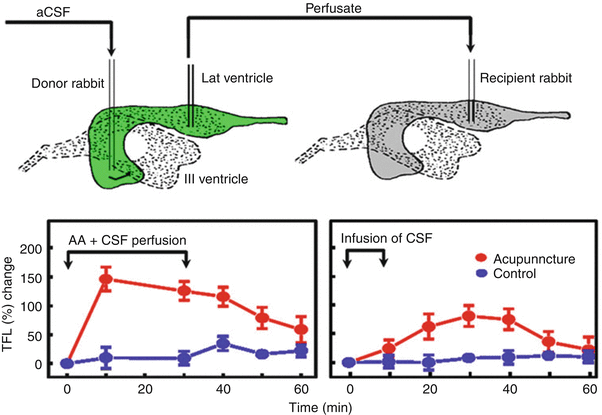

Fig. 10.2
Cross infusion of cerebroventricular fluid between two rabbits. The donor rabbit was subject to acupressure stimulation at the kunlun point near the Achilles tendon. The perfusate of the donor was injected into the lateral ventricle of the recipient rabbit. Latency of the radiant heat-induced head jerk was taken as the nociceptive threshold (Modified from Research Group of Acupuncture Anesthesia, Beijing Medical College [9])
Classical Neurotransmitters
A literature search revealed serotonin, or 5-hydroxytryptamine (5-HT), to be a candidate for the mediators of the analgesic effect. Studies performed in rats and rabbits showed that increase of the availability of 5-HT in brain or spinal cord potentiated acupuncture analgesia, whereas blockade of 5-HT synthesis or receptor activation resulted in a significant decrease of the analgesic effect. All of the results pointed to the conclusion that 5-HT in the central nervous system plays an important role in the mediation of acupuncture analgesia [10].
In contrast to the unique effect of 5-HT in the entire central nervous system, the role played by norepinephrine (NE) was much more complicated. Most of the information suggested that NE in the spinal cord played a facilitatory role for acupuncture analgesia, in contrast to the antagonistic role in the brain [11].
Opioid Peptides and the Frequency Specific Release (Fig. 10.3)
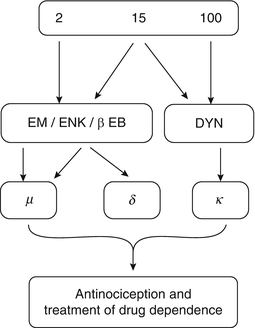
Fig. 10.3
Frequency-dependent release of opioid peptides in the central nervous system. Shown are four kinds of opioid peptides (EM endorphins, ENK enkephalins, βEP β-endorphin, DYN dynorphins), three kinds of opioid receptors (μ, δ, κ), and three representative frequency of electroacupuncture (2, 15, and 100 Hz)
The discovery of enkephalins in the pig brain in 1975 triggered a huge storm in the biomedical field. Every researcher in this field tried to find some relation with endogenous opioid peptides, and there was no exception for researchers of acupuncture analgesia. David Mayor [12] was the first to step into this field. He used the opioid receptor antagonist naloxone as the research tool and found that the analgesic effect of acupuncture for dental pain can be prevented by the subcutaneous injection of naloxone, suggesting the involvement of endogenous opioid substances. Since opioid receptors can be divided into three types, μ, δ, and κ, and naloxone is a nonspecific antagonist for all three kinds of opioid receptors, this pharmacological tool can hardly be used to make a further receptor-type differentiation. Using a specific antagonist for the three types of opioid receptor, Han and colleagues were able to find that the analgesic effect of 2-Hz stimulation is mediated by μ and δ receptor, whereas at 100 Hz, the effect is mediated by κ receptors [13]. Further studies using radioimmunoassay revealed that 2 Hz increased the release of enkephalins and endorphins in the CNS to interact with μ and δ receptors, whereas 100 Hz increased the release of dynorphin in the spinal cord to interact with κ receptors (Fig. 10.3) [13].
An interesting question was that if low- or high-frequency stimulation can only accelerate the release of a fraction of the opioid peptide family, can we design a pattern of frequency which can accelerate the release of all four kinds of opioid peptides. This may have a practical impact since there are reports showing that simultaneous activation of two types of opioid receptors may cause a synergistic effect [14, 15]. After a series of exhausting experiments performed in the rat, it was revealed that a frequency automatically alternating between 2 and 100 Hz, each lasting for 3 s, produced a significantly more potent analgesic effect than pure low or pure high frequency alone [13]. This is reasonable since a fraction of the enkephalins released during the low-frequency period may survive to the next period of high-frequency stimulation when dynorphin is released. The coexisting enkephalin and dynorphin may interact at the receptor sites to produce a synergistic effect.
Anti-opioid Peptides and Acupuncture Tolerance
In performing animal experiments of acupuncture analgesia, two basic phenomena called our attention. One is the marked individual variation or the unpredictability of the acupuncture effect, and the other is the gradual fading of the analgesic effect with time if acupuncture is administered too often in a short period of time. As a general rule, acupuncture analgesia needs time (about 30 min) to build up to its full potential, and the effect would decay when the acupuncture needle is poured off (Fig. 10.1) or left unattended (Fig. 10.4). If EA is given 30 min/h, for 4–5 h, the analgesic effect would decrease gradually (Fig. 10.5) [16]. This is not due to the local tissue damage caused by repeated needle insertion and manipulation, since the situation would remain even if the needle is inserted into a new point of the body without any tissue damage.
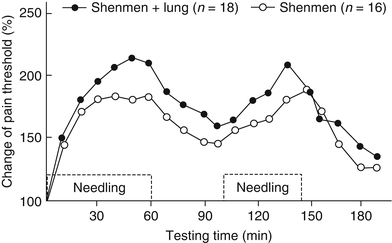
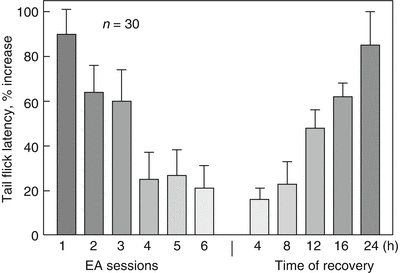

Fig. 10.4
Influence of manual needling at ear acupoint Shenmen (n = 16) or Shenmen plus lung (n = 18) on pain threshold of the skin over the chest and abdomen in humans. The pain threshold increased during the period of needle manipulation and started to decrease when the needle is staying in situ (Modified from Research Group of Ear Acupuncture, Jiangsu College of New Medicine [77])

Fig. 10.5
Repeated electroacupuncture to the rat produced a decrease of the analgesic effect, referred to as acupuncture tolerance. It took 24 h for a full recovery of the acupuncture analgesia (Modified from Han et al. [16])
In searching for the possible mechanisms, a hypothesis was raised that, according to the concept of Yin and Yang balance in the Chinese philosophy, the existence of a natural pain-killing substance (endorphin) might be accompanied by the existence of another substance with an antagonistic effect (anti-opioid substance). After a careful survey, this putative anti-opioid substance was identified as cholecystokinin octapeptide (CCK-8) [17]. In fact, repeated EA produced an increase of the production and release of opioid peptides, and in the same time, there is a gradual increase of the CCK-8 in the central nervous system which plays an antagonistic role against opioids, thereby reduces the effect of EA. This phenomenon is termed “acupuncture tolerance,” to mimic the situation of “morphine tolerance” produced by repeated injection of morphine. It was interesting to find that for rats with CCK predominates over opioid peptides in the central nervous system, they can be a nonresponder toward acupuncture, or a weak responder but quickly developing into acupuncture tolerance. The situation can be reversed if (a) CCK antagonist is injected intracerebroventricularly or intrathecally to the rat, or (b) the gene expression of CCK is blocked by the antisense probe against preproCCK administered centrally. In that case, the nonresponder of acupuncture analgesia can be changed into responder and the diminished analgesic effect can be revived [17, 18]. The lesson learned from this mechanism is that acupuncture should not be given too often, or last too long in one session.
Neural Pathways
From neurophysiological point of view, acupuncture analgesia can be taken as a reflex action. The afferent comes from the nerve fibers (mostly Aβ fibers) innervating the acupoint, and the efferent is the descending pathway modulating the sensitivity of the dorsal horn neurons not only in the same segment but also in heterogenous segments. Studies in the rat revealed that 100-Hz stimulation of the acupoint would trigger the release of dynorphin in the spinal cord. After the destruction of the parabrachial nucleus of the brain stem, high-frequency EA would no longer produce an analgesic effect [19]. Conversely, 2-Hz EA induces the release of β-endorphin in the brain and enkephalin in the whole central nervous system. After the destruction of the arcuate nucleus of the hypothalamus (where β-endorphin neurons aggregated), 2-Hz EA would no longer elicit analgesic effect. Taken together, a diagram could be constructed to show the hypothetical neural pathway for acupuncture analgesia (Fig. 10.6). Neither low- nor high-frequency EA would work if a lesion is placed at the periaqueductal gray (PAG) of the midbrain [19].
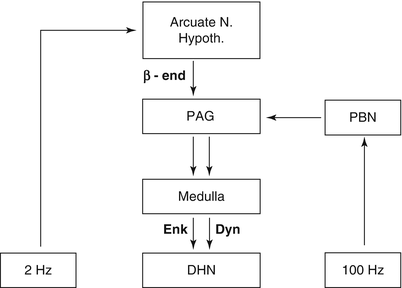

Fig. 10.6
The neural pathway for the analgesic effect induced by electroacupuncture of different frequencies. Arcuate N. Hypoth. arcuate nucleus of hypothalamus, PAG periaqueductal gray of the midbrain, DHN dorsal horn neuron of the spinal cord, PBN parabrachial nucleus, β-end β-endorphin, ENK Enkephalin, DYN dynorphin
Other neural pathways have also been proposed. For example, 100-Hz stimulation can evoke supraspinal long-term depression not only in normal rats [20] but also in sham operated rats subject to neuropathic pain [21], contributing to the mechanisms of high-frequency EA-induced analgesic effect.
A hypothetical diagram was proposed by Han, which gives a general picture of the neural network underlying acupuncture analgesia, at least for the control of the acute pain [6].
Functional magnetic resonance imaging (fMRI) was used to characterize the possible brain areas being involved in mediating the acupuncture effect. Since stimulation of any of the body sites would cause extensive changes in the brain MRI picture, it is hard to characterize the brain sites responsible for acupuncture-induced analgesic effect. Zhang et al. [22] tried to correlate the magnitude of acupuncture-induced BOLD signal change observed in identified brain area with the magnitude of the analgesic effect induced by 2- or 100-Hz EA stimulation,respectively. The results showed that the analgesic effect induced by low and high frequencies seems to be mediated by different, though partially overlapping brain networks. In either frequency, the averaged fMRI activation levels of bilateral secondary somatosensory area and insula, contralateral anterior cingulate cortex, and thalamus were positively correlated with the EA-induced analgesic effect. In the 2-Hz EA group, positive correlation was observed only in contralateral primary and supplementary motor areas, while negative correlation was observed in bilateral hippocampi. In 100-Hz EA group, positive correlations were observed in contralateral inferior parietal lobule and ipsilateral anterior cingulate cortex, while negative correlation was found in contralateral amygdale. These results suggest that functional activation of certain brain areas might be correlated with the effect of EA analgesia in a frequency-dependent manner. More work is needed in order to figure out the complicated neural network controlling acupuncture-induced analgesic effect.
Mode of Stimulation (MA, EA, TEAS)
In clinical practice, various kinds of methods have been used to secure the optimal stimulation of the acupoint. Manual needling (MA) is the classical technique, with the characteristics of preciseness, capable of directing the needle in various angles to find the maximal deqi sensation and freely adjusting the needle movement to obtain a specific effect termed “warm,” “cold,” etc.
Studies show that various kinds of manual needling produce different pattern of afferent impulses in the sensory nerves and activation of the dorsal horn neurons. Out of 12 different kinds of needle manipulation, Wang et al. [23] studied three most popularly used modes, that is, twist, drag-plug, and gradual mode, respectively. Single-unit recordings of the dorsal horn neuron of the rat showed clearly different patterns in the inter-spike intervals (ISI). Based on the reconstructed phase space, they analyzed the spatiotemporal behavior of the time series. The largest Lyapunov exponent, which is an important parameter for describing the nonlinear system behavior, varies significantly in different modes of acupuncture. However, various types of manual needling technique (e.g., “burning mountain” for hot, “frozen sky” for cold) need years to learn and to master.
Compared to manual needling, electroacupuncture (EA) is a modern approach based on the basic finding that the effect of acupuncture is relied on the integrity of the nervous system [7] and that delivering specific forms of electric impulses is the easiest way to activate the afferent nerves in a predictable manner, with the added advantage of time saving and very high reproducibility. Aside from the great time saving and the reproducibility of the treatment, a significant advantage of using EA is that you can try, in certain degree, to change the internal environment of the central nervous system according to the ever changing need of the body system, for example, the use of low frequency (2–4 Hz) for the production and release of enkephalins in the central nervous system and high frequency (80–120 Hz) for dynorphins in the spinal cord [13]. The clinical effects produced by EA of different frequencies can be very different. Study shows that for treatment of rat model of neuropathic pain produced by lumbar nerve ligation, 2 Hz is much effective than 100 Hz, with the involvement of mu opioid receptors [24]. In contrast, for the treatment of patients with spinal cord injury-induced muscle spasm, it is only 100 Hz, but not 2 Hz, which works [25], with the involvement of kappa opioid receptors [26]. In these extreme cases, one frequency may serve as the control of the other. Here, the credibility of the design for “control” is nearly perfect, since no one knows which frequency is better, even for the care provider. This frequency-specific design can be served as an example to show the specificity of the EA treatment, rather than a design of using a nonspecific skin touch for psychological “believing.” However, the frequency specificity does not apply for every disease. For example, for the treatment of rat model of complete adjuvant-induced arthritis, both high- and low-frequency EA work at a similar efficacy [27].
Unlike electroacupuncture (EA) which uses percutaneous (invasive) approach, the transcutaneous electric acupoint stimulation (TEAS) is a noninvasive way of stimulating the acupoint by the use of skin pads placed on the skin surface overlying the acupoint in lieu of the needle. This is also called “acupuncture without a needle.” Since the skin electrode is usually 4 × 4 cm in size, it would never miss the “acupoint.” Since all the parameters are shown on the LED screen precisely, it can also be used by the patient or family under the instruction of the acupuncturist or the physician, thereby reduces the number of visit to the doctor.
The efficacy of EA in pain control has repeatedly been shown to be no less than manual needling. Wang et al. [28] had done a careful study in the rat experiment, comparing the analgesic effect produced by EA or TEAS, with the conclusion that TEAS is at least as effective, if not more effective, than EA. The analgesic effect produced by either method can be blocked by naloxone at the same degree, suggesting a similar underlying mechanism of action. Given that these forms of acupoint stimulation may have similar therapeutic effect and underlying mechanisms, we will make clear statement separately for MA, EA, and TEAS in the following text when clinical applications are to be mentioned.
In the recent literature, there is another term called “percutaneous electrical nerve stimulation (PENS)” in contrast to “transcutaneous electrical nerve stimulation (TENS)” [29]. In a commentary put forwarded by Cummings [30], the author mentioned that “PENS is neither different in principle nor in practice from EA. While the term accurately reflects the nature of the treatment, there is no substantial justification for referring to PENS as a novel therapy.”
Clinical Examples and the Usefulness in Clinical Practice
Acupuncture Anesthesia During the Surgical Procedure
In the late 1950s up to 1970s, there was a large-scale clinical practice in China of using acupuncture in lieu of anesthetics for surgical procedures, named “acupuncture anesthesia.” In fact, in most hospitals, acupuncture was used in combination with anesthetics to form a “complex acupuncture anesthesia,” or “acupuncture-assisted anesthesia (AAA).” To take a few examples, in the Tiantan hospital of Beijing specialized for brain surgery, Wang et al. [31] reported that in a series of cranial operations, they can reduce the dosage of enflurane by 45–48 % while fulfilling all the requirements of a successful anesthesia. This may be especially interested by the new trend of “anesthesia for awake neurosurgery” [32]. Qu et al. [33] performed kidney transplantation under combined acupuncture/epidural anesthesia in the Shanghai First People’s Hospital. They reported a reduction of procaine usage for 48 % with robust satisfaction. Almost all the reports concerning the complex acupuncture anesthesia stressed the benefits of earlier recovery, less postoperative pain and other complications, and shortened hospitalization. Sim et al. [34] reported 90 patients randomly assigned to one of three groups: group I − placebo EA, group II − preoperative EA for 45 min, and group III − 45 min of postoperative EA. The results showed that preoperative EA leads to a reduced intraoperative alfentanil consumption and has a morphine-sparing effect during the early postoperative period. However, this was not universally confirmed by report from other group [35].
Postoperative Pain
In contrast to some controversy whether acupuncture can reduce the anesthetic use during the surgical procedure, there is a unanimous agreement that acupuncture could significantly reduce the postoperative pain. Paul White’s group published the first paper of a series of studies in 1997 [36], using the electronic device (HANS) for transcutaneous electrical acupoint stimulation (TEAS) to assess if it can reduce the postoperative PCA requirement for hydromorphone (HM). In a single-blind controlled study, they found that compared to the blank control of “PCA only” group, the HM used in the sham TEAS group showed a 22 % reduction. For the real TEAS group, they used two levels of intensity, the threshold level (4–5 mA) and the double threshold level (9–12 mA), resulting in a 34 % (P < 0.05) and 65 % (P < 0.001) reduction, respectively. The postoperative side effects (nausea, dizziness, pruritis, and sedation) were also significantly reduced. Similar results were reported for reduction of postoperative pain [37–40], nausea, and vomiting [40–42].
Since acupuncture or its several variants are shown by evidence-based medicine to be so cost effective for controlling postoperative pain, nausea, vomiting, and lack of clinical toxicity, Dr. White called on more clinicians to incorporate these acustimulation techniques into their perioperative therapeutic armamentarium [43]. In an accompanying editorial, the editor in chief suggested that, “once the mechanism of action is understood, claims of clinical efficacy for acustimulation will no longer be extraordinary” [44].
Low Back Pain
Low back pain (LBP) is one of the most common causes for primary care clinic visits, only second to common cold, and it is the second most common cause of absence from work in adults who are over 55 years of age. According to the National Center of Complementary and Alternative Medicine (NCCAM), NIH, people use acupuncture for various types of pain, and back pain is the most commonly reported, followed by joint pain, neck pain, and headache [2].
In a study reported by Ghoname et al. [45], 60 patients of LBP were divided into four groups to compare the effectiveness of PENS (equivalent to EA) with sham-PENS, TENS, and exercise. PENS is significantly more effective in decreasing the VAS pain scores after each treatment than the other three groups. The average daily oral intake of non-opioid analgesics (2.6 ± 1.4 pills/day) was decreased to 1.3 ± 1.0 pills/day with PENS (P < 0.008) compared with 2.5 ± 1.1, 2.2 ± 1.0, and 2.6 ± 1.2 pills/day with sham-PENS, TENS, and exercise, respectively. Compared with the other three modalities, 91 % of the patients reported that PENS was the most effective in decreasing their LBP. The PENS therapy was also significantly more effective in improving physical activity, quality of sleep, and sense of well-being (P < 0.05 for each).
The SF-36 survey confirmed that PENS improved posttreatment function more than sham-PENS, TENS, and exercise [45]. In another study, 68 LBP patients secondary to degenerative lumbar disc diseases were treated with EA of different frequencies: 4 Hz, alternating 15 and 30 Hz, 100 Hz, and 0 Hz serving as control. Each treatment was administered for a period of 30 min, three times per week for 2 weeks. In contrast to the control group which produced little improvement, all other groups produced significant decreases in the severity of pain and improvement in the quality of life. Of the three frequencies, 15/30 Hz was the most effective in decreasing pain. Therefore, the alternative low and high frequency was more effective than with low or high frequency alone [46]. This replicates what we found in the rat experiment where 2/100 Hz was significantly better than only 2 or 100 Hz alone in the antinociceptive effect [47].
Further studies revealed that as far as analgesic effect is concerned, needle insertion plus electrical stimulation (EA) is much better than needle staying without stimulation [46, 48], acupuncture-like TENS is better than ordinary TENS [49], and dermatomal stimulation (lumbar region for back pain, neck region for neck pain ) is better than stimulation at the distal sites [50].
In summary, while most of the studies showed that acupuncture or EA are effective for low back pain, there are negative reposts [51]. Concerning the life span of the therapeutic effect, it may be short lasting [52] or longer lasting for at least 3 months [48], depending on the design of the protocol, especially the number of treatment being used.
Osteoarthritis of the Knee
Acupuncture seems to be effective for osteoarthritis, especially in the area of the knee. However, controversy exists on the clinical effectiveness. Moreover, difference in the design, sample size, and protocol of the studies made it hard to draw any definitive conclusions. Here, we make comparison of two articles using acupuncture for the treatment of osteoarthritis of the knee joint, both published in the Annals of Internal Medicine, one got negative result [52] and another positive result [53]. We hope to find out some meaningful differences in experimental design, data collection, and interpretation.
From the comparisons made above, we can see that in order to depict a difference between the true and placebo acupuncture groups, one should consider the following: (a) to strengthen the effect of true acupuncture by more treatment sessions. Compared to Berman et al. who used 23 sessions, Scharf et al. used only 10. (b) Berman et al. [53], but not Scharf et al. [54], used EA to supplement manual needling (1 vs. 0) and (c) to weaken the effect of placebo or sham acupuncture by reducing the number of needle insertion (2 vs. 10). Aside from that, there are several related issues need to be considered in the future studies (Table 10.1).
Berman et al. [53] | Scharf et al. [54]

Full access? Get Clinical Tree
 Get Clinical Tree app for offline access
Get Clinical Tree app for offline access

|
|---|



